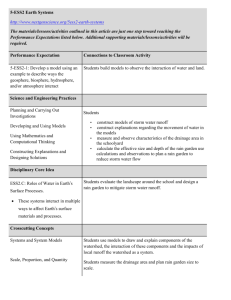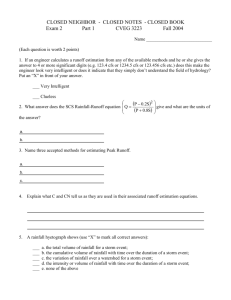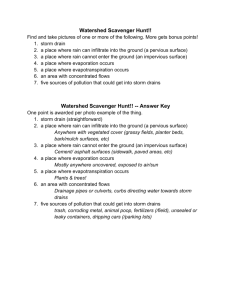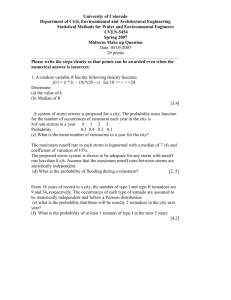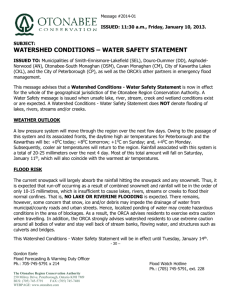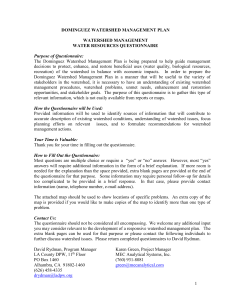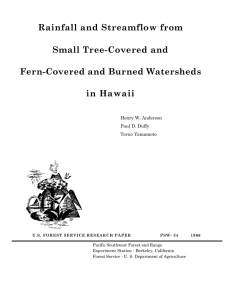NR 285/Geog 295: Environmental Hydrology
advertisement
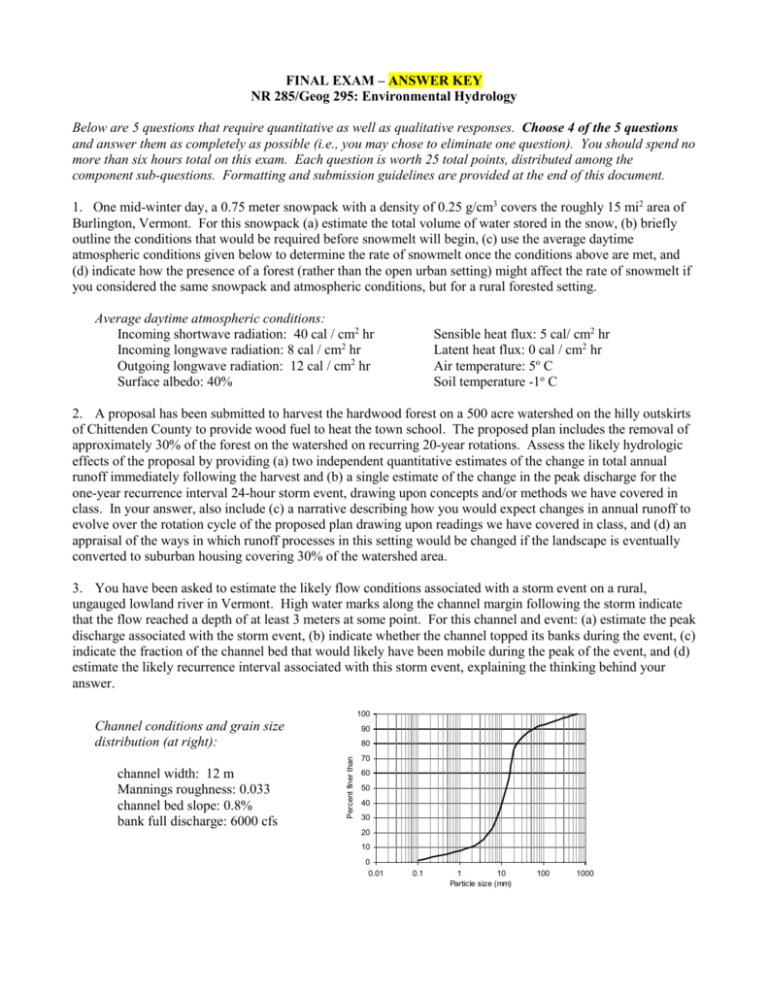
FINAL EXAM – ANSWER KEY NR 285/Geog 295: Environmental Hydrology Below are 5 questions that require quantitative as well as qualitative responses. Choose 4 of the 5 questions and answer them as completely as possible (i.e., you may chose to eliminate one question). You should spend no more than six hours total on this exam. Each question is worth 25 total points, distributed among the component sub-questions. Formatting and submission guidelines are provided at the end of this document. 1. One mid-winter day, a 0.75 meter snowpack with a density of 0.25 g/cm3 covers the roughly 15 mi2 area of Burlington, Vermont. For this snowpack (a) estimate the total volume of water stored in the snow, (b) briefly outline the conditions that would be required before snowmelt will begin, (c) use the average daytime atmospheric conditions given below to determine the rate of snowmelt once the conditions above are met, and (d) indicate how the presence of a forest (rather than the open urban setting) might affect the rate of snowmelt if you considered the same snowpack and atmospheric conditions, but for a rural forested setting. Average daytime atmospheric conditions: Incoming shortwave radiation: 40 cal / cm2 hr Incoming longwave radiation: 8 cal / cm2 hr Outgoing longwave radiation: 12 cal / cm2 hr Surface albedo: 40% Sensible heat flux: 5 cal/ cm2 hr Latent heat flux: 0 cal / cm2 hr Air temperature: 5o C Soil temperature -1o C 2. A proposal has been submitted to harvest the hardwood forest on a 500 acre watershed on the hilly outskirts of Chittenden County to provide wood fuel to heat the town school. The proposed plan includes the removal of approximately 30% of the forest on the watershed on recurring 20-year rotations. Assess the likely hydrologic effects of the proposal by providing (a) two independent quantitative estimates of the change in total annual runoff immediately following the harvest and (b) a single estimate of the change in the peak discharge for the one-year recurrence interval 24-hour storm event, drawing upon concepts and/or methods we have covered in class. In your answer, also include (c) a narrative describing how you would expect changes in annual runoff to evolve over the rotation cycle of the proposed plan drawing upon readings we have covered in class, and (d) an appraisal of the ways in which runoff processes in this setting would be changed if the landscape is eventually converted to suburban housing covering 30% of the watershed area. 3. You have been asked to estimate the likely flow conditions associated with a storm event on a rural, ungauged lowland river in Vermont. High water marks along the channel margin following the storm indicate that the flow reached a depth of at least 3 meters at some point. For this channel and event: (a) estimate the peak discharge associated with the storm event, (b) indicate whether the channel topped its banks during the event, (c) indicate the fraction of the channel bed that would likely have been mobile during the peak of the event, and (d) estimate the likely recurrence interval associated with this storm event, explaining the thinking behind your answer. 100 Channel conditions and grain size distribution (at right): 80 Percent finer than channel width: 12 m Mannings roughness: 0.033 channel bed slope: 0.8% bank full discharge: 6000 cfs 90 70 60 50 40 30 20 10 0 0.01 0.1 1 10 Particle size (mm) 100 1000 4. You’ve been asked to design a stormwater detention system for a 10 square mile watershed in Vermont that has a maximum point intensity-duration-frequency storm event pattern shown in the graph below. This 10 square mile area is a residential area generally characterized by ½ acre lots on D type soils with a combination of oaks and pines among lawns that are in good condition. The soils are 30 feet thick over a bedrock confining layer. The initial design criteria are that you have to detain the storm water volume contained in the 2 year/12 hour storm. a) What is the average intensity of rainfall that you would expect to occur over the 10 square mile area? b) What is the total rainfall volume that will fall on this watershed during the event? c) How much of this rainfall volume do you expect to have to detain? Note: You do not need to run a model here, though a semiquantitative estimate is possible. I’m more interested in your narrative rationale for the volume of rainfall that will end up as runoff and why. Decide on a value for runoff volume, justify it, and the use in the next section. d) Local stormwater design criteria state that detention facilities can not be more than 5 feet deep and it is recommended that no single facility in a multi-facility system (if that becomes necessary) should be greater than 40,000 ft2 in area. Can you recommend a single facility or will you have to go with a multi-facility system? e) No matter what you do, the structural engineering consultants tell you that for safety reasons it is a bad idea to expose the system even one time to a 50 year/1 h storm while the system is under construction. The client you are working with (a city council) is willing to tolerate a 5% chance that this type of storm might occur after the construction starts. If this is the case, then once you have broken ground on the system, what is the maximum time you can take (in whole years) to complete the project without exceeding the client’s risk tolerance? f) The structural engineering consultants have also told you that if there are more than five 10 year/1 h storm events over the design life of the system (30 years), then there is some maintenance that should be done to ensure that the system operates at optimal performance. The client wants to know whether this is likely or not, so that they can decide whether to budget for this maintenance cost or not. If there is less than a 1-in-5 chance of this occurring, the client is willing to not budget for the maintenance. What do you recommend? 5. Consider the reach width and depth data in the table at the right. You’ve been asked to do the preliminary planning for a slug addition experiment in which you will compare the flow at two different reaches in the watershed. The first reach is at a point that drains 50 square miles and the other drains 25 square miles. Other characteristics of the two reaches are provided in the table below. Parameter Velocity Incision ratio Slope Substrate Location Land use Conductivity 25 Sq. Mile 50 Sq. Mile watershed watershed 0.5 0.6 1.16 1.05 0.03 0.01 gravel/cobble smooth sand mountains plain forest agriculture 73 234 Units m/s dimensionless m/m uS/cm Watershed Reach ID size (#) (Sq. miles) 1 71.3 3 69.3 5 67.5 6 56.3 7 54.1 8 42.1 9 41.5 11 26.2 17 17.8 18 17.3 19 16.9 27 9.9 33 13.5 Width (feet) 116.0 108.0 95.0 84.0 87.0 73.0 87.0 75.0 64.0 62.0 58.5 33.5 43.0 Depth (feet) 2.53 3.00 3.07 2.62 1.90 2.88 2.20 2.29 2.10 2.22 1.83 1.96 1.68 5 (continued) a) What is the width and depth that you would expect for the 25 and 50 sq. mile reaches? Quantify you answers. b) What is the optimal mixing length you should expect for these two reaches? c) How much Rhodamine WT dye should you use for the experiments at these two sites? Assume that the dye comes in the standard stock solution of 20% mass/volume (200 g/L). Note: It is unnecessary to worry about the specific gravity of the stock material. To address this problem you will need to make some assumptions and you will need to fill in at least one important blank with a preliminary estimate. d) Sketch a graph of what you would expect to see if you were collecting data with a properly calibrated (and operational) field fluorometer at the optimal mixing length in the two streams. Provide a detailed narrative explanation of the patterns you have sketched. General guidelines for preparing and submitting your responses: Use any of the concepts, readings, exercises or labs we have covered this semester in crafting your answers. For answers requiring calculations, show your work in full to receive full credit. If you need to make an assumption to answer a question, do so and clearly state your assumption(s). Start each numbered question on a new page with your name included on every page, so that we may separate questions and grade individually. We strongly encourage you to craft your narrative response in MS/Word in standard formatting (Times Roman, 11pt, single spaced, doubled sided, 1” margins) with supplemental hand written notes and calculations as needed. Embedded Excel spreadsheets or other graphics are fine. If you choose to hand write your entire response, ensure that they are legible. Responses with illegible writing or undecipherable logic can not be graded. (Partial credit will be awarded wherever we can.) Your responses are due no later than 6:00pm on Friday, December 7 to Beverley in Old Mill 202. We prefer a hard copy submission to avoid the possibility that what we receive is not exactly what you intended to submit or that we would fail to receive your response before we leave town for the weekend. If you need to make other arrangements, please speak to Beverley directly.

